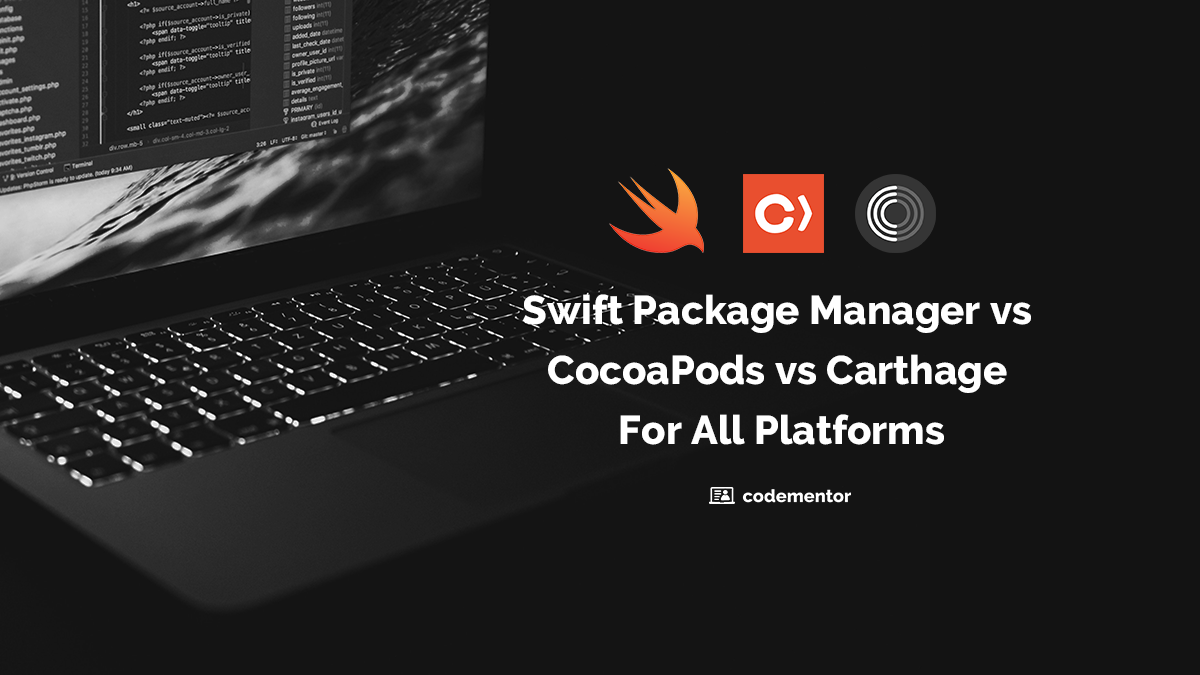In Swift there are two categories of types: value types and reference types. A value type instance keeps a unique copy of its data, for example, a struct or an enum. A reference type, shares a single copy of its data, and the type is usually a class.
We’ll also discuss types like tuples, closures, and functions, how they work, how to use them, and what happens when you mix types.
You’ll use Xcode 10.1 and Swift 4.2 in this tutorial.
First, create a new Playground in Xcode. You'll use it to experiment with the code in this tutorial.
Value Types vs Reference Types
Value Types
A value type instance is an independent instance and holds its data in its own memory allocation. There are a few different value types: struct, enum, and tuple.
Struct
Let’s experiment with structs and prove that they’re value types:
Add the following code to your playground:
// 1
struct Car {
let brand: String
var model: String
}
// 2
var golf = Car(brand: "Volkswagen", model: "Golf")
// 3
let polo = golf
// 4
golf.model = "Golf 2019"
// 5
print(golf)
print(polo)
In the code above, you will:
- Create a
Carstruct withbrandandmodelproperties. - Create a new instance of
Carnamedgolf. - Create a copy of the
golfinstance, namedpolo. - Change the
golf.modelvariable toGolf 2019 - Print the 2 different instances. The first
printstatement printsCar(brand: "Volkswagen", model: "Golf 2019")in the Console. The second one printsCar(brand: "Volkswagen", model: "Golf"). Even ifpolois a copy ofgolf, the instances remain independent with their own unique data copies.
With this simple playground, we’ve confirmed that structs are indeed value types.
Enum
To check that enums are value types, add this code to the playground:
// 1
enum Language {
case italian
case english
}
// 2
var italian = Language.italian
// 3
let english = italian
// 4
italian = .english
// 5
print(italian)
print(english)
In the code above, you will:
- Create a
Languageenum withitalianandenglishcases. - Create a new instance of
Languagefor theitalianlanguage. - Create a copy of the
italianinstance, namedenglish. - Change the
italianinstance toenglish. - Print the two different instances. The first
printstatement printsenglish, and the second one printsitalian. Even ifenglishis a copy ofitalian, the instances remain independent.
Tuple
The last value type that we'll explore is tuple. A tuple type is a comma-separated list of zero or more types, enclosed in parentheses. You can access its values using the dot (.) notation followed by the index of the value.
You can also name the elements in a tuple and use the names to access the different values.
Add the following code to the playground:
// 1
var ironMan = ("Tony", "Stark")
// 2
let parent = ironMan
// 3
ironMan.0 = "Alfred"
// 4
print(ironMan)
print(parent)
In the code above, you will:
- Create an
ironMantuple with the stringsTonyandStark. - Create a copy of the
ironManinstance, namedparent. - Change the
ironMan.0index toAlfred. - Print the 2 different instances. The first
print, prints("Alfred", "Stark")and the second one, prints("Tony", "Stark"). Again, the instances remain independent.
You can now be certain that structs, enums, and tuples are value types! 
Source: Marvel Entertainment
When to Use Value Types
Use value types when comparing instance data with == makes sense.
== checks if every property of the two instances is the same.
With value types you always get a unique, copied instance, and you can be sure that no other part of your app is changing the data under the hood. This is especially helpful in multi-threaded environments where a different thread could alter your data.
Use a value type when you want copies to have an independent state, and the data will be used in code across multiple threads.
In Swift, Array, String, and Dictionary are all value types.
Reference Types
In Swift, reference type instances share a single copy of their data, so that every new instance will point to the same address in memory. A typical example is a class, function, or closure.
To explore these, add a new function to your playground:
func address<T: AnyObject>(of object: T) -> Int {
return unsafeBitCast(object, to: Int.self)
}
This function prints the address of an object, which will help you check whether you're referencing the same instance or not.
Class
The first reference type that you'll look at is a class.
Add the following code to your playground:
// 1
class Dog: CustomStringConvertible {
var age: Int
var weight: Int
// 2
var description: String {
return "Age \(age) - Weight \(weight)"
}
// 3
init(age: Int, weight: Int) {
self.age = age
self.weight = weight
}
}
// 4
let doberman = Dog(age: 1, weight: 70)
// 5
let chihuahua = doberman
// 6
doberman.age = 2
// 7
chihuahua.weight = 10
// 8
print(doberman)
print(chihuahua)
// 9
print(address(of: doberman))
print(address(of: chihuahua))
In the code above, you will:
- Create a new
classnamedDog, that conforms toCustomStringConvertibleto print the custom descriptions of the object. - Define the custom description of the object.
- Create a new
initfunction. This is needed because, unlike astruct, aclassdoesn't automatically create an initialization function based on the variables of the object. - Create a
dobermaninstance ofDog. - Create a copy of
doberman, namedchihuahua. - Change the
doberman.ageto2. - Change the
chihuahua.weightto10. - Print the description of the two different instances. The first
print, printsAge 2 - Weight 10, and the second one prints the same;Age 2 - Weight 10. This is because you're actually referencing the same object. - Print the address of the two different instances. With these prints, you'll be sure that you're referencing the same address. You'll see that both
printstatements print the same value.
You can rest assured that a class is a reference type.
Functions and Closures
A closure is used to refer to a function along with the variables from its scope that it encapsulates. Functions are essentially closures that store references to variables in their context.
Take a look at the code below:
let closure = { print("Test") }
func function() -> (){ print("Test") }
closure()
function()
They both do the same thing.
You can find more info about closures in Swift's docs.
When to Use Reference Types
Use a reference type when comparing instance identity with === makes sense. === checks if two objects share the same memory address.
They’re also useful when you want to create a shared, mutable state.
As a general rule, start by creating your instance as an enum, then move to a struct if you need more customization, and finally move to class when needed.
Mutability
The mutability of value types lets you specifically choose what variables can be modified or not.
Add this code to your playground:
// 1
struct Bike {
// 2
let radius: Int
var km: Float
}
// 3
let bike = Bike(radius: 22, km: 34.5)
In this code, you will:
- Create a
Bikestruct. - Create a
letand avarproperty. - Create a
Bikeconstant. Even ifkminside theBikestructis avar, you can't edit that becausebikeis alet.
If you create a struct constant, you can’t change the values of its properties, even though the values themselves might be variables.
A class, on the other hand, lets you change them because you are referencing the memory address of the object.
Add the following code:
// 1
class Motorbike {
// 2
let radius: Int
var km: Float
init(radius: Int, km: Float) {
self.radius = radius
self.km = km
}
}
// 3
let motorbike = Motorbike(radius: 22, km: 34.5)
motorbike.km += 1
// 4
print(motorbike.km)
In the code above, you will:
- Create a
Motorbikeclass. - Create
radiusasletandkmasvar. - Add 1 to the
motorbike.kmvariable. - Print the
motorbike.kmvariable.
You can set the km variable because Motorbike is a class and we are referencing its memory address.
Source: Warner Bros. Pictures
Nonmutating Keyword
There is also a nonmutating keyword, which can specify that a constant can be set without modifying the containing instance, but instead has global side effects.
Again, add this code to the playground:
// 1
import Foundation
// 2
struct Cat: CustomStringConvertible {
// 3
var name: String? {
// 4
get {
return UserDefaults.standard.string(forKey: "CatName")
}
// 5
nonmutating set {
if let newValue = newValue {
UserDefaults.standard.set(newValue, forKey: "CatName")
} else {
UserDefaults.standard.removeObject(forKey: "CatName")
}
}
}
var description: String {
return name ?? ""
}
}
// 6
let cat = Cat()
cat.name = "Sam"
// 7
let tiger = Cat()
tiger.name = "Olly"
In the code above, you:
- Import
Foundationbecause playgrounds don't do that by default. - Create the
Catstruct. - Create the
namevariable. - Specify how to
gettheCatname, by accessing theUserDefaults. - Specify the
nonmutatingsetbehavior to set the new name inUserDefaultsif notnil, otherwise remove it. - Create a new
Catinstance, namedcat, and set itsnameto "Sam". - Create a new
Catinstance, namedtiger, and set itsnameto "Olly".
So, what’s going on here? Both the cats have "Olly" as their name because they’re using UserDefaults to get their name. Also, even if both are constants, you can set their name property without any warning or error.
Mixed Types
What happens when you mix value types with reference types and vice versa?
You may often run into complications by mixing these types together. Let’s take a look at some examples so that you can avoid these common pitfalls.
Mixing Value Types in Reference Types
Let’s start by mixing value types in reference types by adding a struct inside a class and see what happens.
Let's say that you have a manufacturer that produces some device. You'll create a class Device and a struct Manufacturer.
Add the following code to the playground:
// 1
struct Manufacturer {
var name: String
}
// 2
class Device {
var name: String
// 3
var manufacturer: Manufacturer
init(name: String, manufacturer: Manufacturer) {
self.name = name
self.manufacturer = manufacturer
}
}
// 4
let apple = Manufacturer(name: "Apple")
// 5
let iPhone = Device(name: "iPhone", manufacturer: apple)
let iPad = Device(name: "iPad", manufacturer: apple)
// 6
iPad.manufacturer.name = "Google"
// 7
print(iPhone.manufacturer.name)
print(iPad.manufacturer.name)
In the code above, you will:
- Create a
Manufacturerstruct with a name property. - Create a
Deviceclass with a name and manufacturer properties. - Declare the manufacturer of the device.
- Create a manufacturer named "Apple".
- Create two devices, "iPhone" and "iPad".
- Apple sold the iPad division to "Google".
- Print the two manufacturer names.
You'll see that the two devices now have different manufacturers. The iPhone has Apple as the manufacturer and the iPad has Google as the manufacturer.
This is an example of how mixing value types in reference types works. Even if you are using the same instance of Manufacturer, two copies will be created when the instance is inside a reference type.
Mixing Reference Types in Value Types
Now we'll go over what happens when you mix reference types inside value types.
This time you'll have two airplanes and one engine. You'll define an Airplane struct and an Engine class. Of course, an airplane has an engine.
Add the following code:
// 1
class Engine: CustomStringConvertible {
var description: String {
return "\(type) Engine"
}
var type: String
init(type: String) {
self.type = type
}
}
// 2
struct Airplane {
var engine: Engine
}
// 3
let jetEngine = Engine(type: "Jet")
// 4
let bigAirplane = Airplane(engine: jetEngine)
let littleAirplane = Airplane(engine: jetEngine)
// 5
littleAirplane.engine.type = "Rocket"
// 6
print(bigAirplane)
print(littleAirplane)
In the code above, you will:
- Create the
Engineclass, with itstype. - Create the
Airplanestruct, with anengine. - Create a jet engine.
- Create two airplanes, with the same
Engineinstance. - Change the
littleAirplaneengine to a "Rocket" one. - Print the two airplane objects.
As you can see, both of the airplanes have the same engine, the Rocket Engine. This is because you're referencing the same Engine instance. Even if you created two instances of an Airplane, with the same Engine, they won’t copy the reference type like value types.
Source: Marvel Entertainment
Pointers
In Swift, you can refer to an instance by using the inout keyword in function signatures. Using inout means that modifying the local variable will also modify the passed parameters. Without it, the passed parameters will remain the same value.
Add the following code:
// 1
func addKm(to bike: inout Bike, km: Float) {
bike.km += km
}
// 2
var awesomeBike = Bike(radius: 22, km: 20)
// 3
addKm(to: &awesomeBike, km: 10)
// 4
print(awesomeBike)
In the code above, you will:
- Create an
addKmfunction that takes aninoutBikeparameter. - Create the new
Bikeinstance, namedawesomeBike. - Call the
addKmwith the&operator. The&operator tells the function to pass the address of the variable instead of a copy of it. - Print the
awesomeBikeinstance.
You'll see that by printing the awesomeBike variable, its km will be 30 because you're not creating a copy of it. Instead, you are using the same instance.
Reference types work in the same way. You can pass them with inout or not, and the result will be the same.
Add this code to the playground:
func addKm(to motorbike: inout Motorbike, km: Float) {
motorbike.km += km
}
var awesomeMotorbike = Motorbike(radius: 30, km: 25)
addKm(to: &awesomeMotorbike, km: 15)
print(awesomeMotorbike.km)
Just like before, you've created a new Motorbike instance, named motorbike and passed it to the addKm function. The final print will print 40 km.
Now add the following code:
func addKm(to motorbike: Motorbike, km: Float) {
motorbike.km += km
}
addKm(to: awesomeMotorbike, km: 15)
print(awesomeMotorbike.km)
The results are the same. Your final motorbike instance now has 55 km.
Summary
Now you've learned all the differences between value types and reference types in Swift, how to use them, how they work, and which one better fits your needs.
You can download the final playground for this post here.
One great advantage of using the default Swift value types like Array is the Copy on Write feature. That can be your next step in learning the differences between value types and reference types!
Here is a list of other useful links:
- Value and Reference Types by Apple
- Memory Safety by Swift Language Guide
- Structures and Classes by Swift Language Guide
If we missed anything, let us know in the comments section below!


